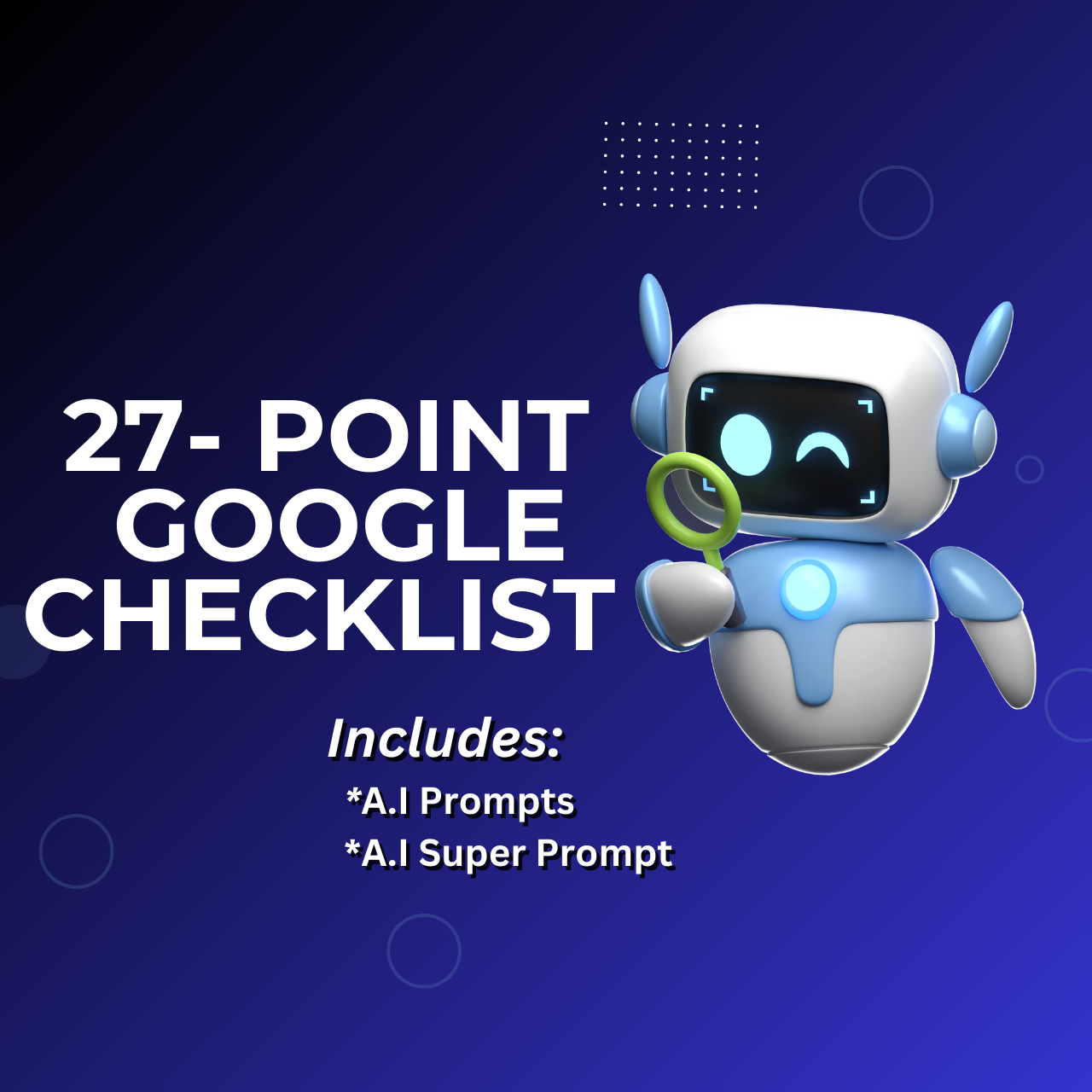Unleash the power of Google Ads and skyrocket your sales with this comprehensive 27-point checklist!
Whether you're a seasoned entrepreneur or just starting your online journey, mastering Google Ads is essential for attracting new customers and achieving your business goals. This guide will equip you with the knowledge and strategies to create high-performing campaigns that deliver real results.

What's Inside This Free Powerful 27-Point Checklist?
Campaign Setup and Structure:
- Defining Clear Goals: It emphasizes the importance of setting specific, measurable goals for your campaigns (e.g., increase website traffic, generate leads, drive sales).
- Choosing the Right Campaign Type: It guides you in selecting the appropriate campaign type (Search, Display, Shopping, Video) based on your business objectives.
- Creating Well-Structured Ad Groups: It advises on organizing keywords and ads into relevant themes for better targeting and campaign management.
- Setting a Realistic Budget: It encourages setting a budget that aligns with your financial capabilities and campaign goals.
- Setting a Bidding Strategy: It helps you choose the right bidding strategy (manual or automated) based on your campaign needs and expertise.
Keyword Research and Targeting:
- Identifying Relevant Keywords: It highlights the use of keyword research tools to find the terms your potential customers are searching for.
- Optimizing Match Types: It explains the importance of using different keyword match types (broad, phrase, exact) to control how your ads are triggered.
- Implementing Negative Keywords: It guides you on adding negative keywords to prevent your ads from showing for irrelevant searches, saving your budget.
- Geo-Targeting: It emphasizes targeting specific geographic locations to reach your desired audience.
- Device Targeting: It advises on optimizing your campaigns for different devices (desktop, mobile) based on your target audience's preferences.
- Audience Targeting: It explains how to define your ideal customer based on demographics, interests, and behaviors for more effective targeting.
Ad Copy Creation:
- Writing Compelling Headlines: It stresses the importance of creating attention-grabbing headlines that include relevant keywords and benefits.
- Crafting Persuasive Ad Copy: It guides you on writing ad copy that clearly describes your offerings and includes a strong call to action (CTA).
- Strong Call to Action (CTA): It highlights the need for a clear and concise CTA to encourage users to take the desired action.
- Utilizing Ad Extensions: It suggests using ad extensions (sitelinks, callouts, location info) to enhance ad visibility and provide more information.
- A/B Testing Ad Variations: It encourages testing different versions of your ads to identify what performs best.
Landing Page Optimization:
- Creating Relevant Landing Pages: It emphasizes aligning your landing pages with your ad copy for a consistent user experience.
- Optimizing Page Speed: It stresses the importance of fast-loading pages for better user experience and higher conversion rates.
- Clear Value Proposition: It advises on clearly communicating the benefits of your product or service to visitors.
- Mobile-Friendly Design: It highlights the necessity of having mobile-optimized landing pages to cater to mobile users.
Conversion Tracking and Analytics:
- Setting Up Conversion Tracking: It explains how to track conversions (leads, purchases) to measure campaign effectiveness.
- Monitoring Key Metrics: It guides you on tracking important metrics (clicks, impressions, conversions, cost-per-conversion) to assess campaign performance.
- Utilizing Google Analytics: It encourages integrating Google Analytics for deeper insights into your campaigns and website traffic.
- Analyzing Performance Regularly: It stresses the importance of regularly reviewing data to identify areas for improvement and optimization.
Continuous Optimization:
- Keyword Optimization: It advises on regularly reviewing and adjusting your keyword list to ensure relevance and effectiveness.
- Ad Schedule Optimization: It suggests optimizing ad scheduling based on when your target audience is most likely to engage with your ads.
- Staying Updated on Google Ads Updates: It emphasizes staying informed about the latest Google Ads features, updates, and best practices.
AI Super Prompt:
The checklist also includes an "AI Super Prompt" that provides detailed guidelines and prompts for using AI tools to create a comprehensive Google Ads campaign strategy, covering all the key areas mentioned above.
This checklist essentially provides a roadmap for creating, managing, and optimizing successful Google Ads campaigns, making it a valuable resource for any small business looking to leverage the platform for growth.
Ready to Take Your Website to the Next Level?


